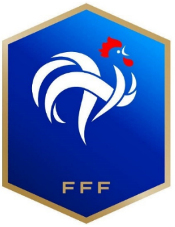
22 Jan Clash of Roosters in the EU
On 15/01/2025, the General Court of the European Union delivered a judgment in the case Kokito I Punt v EUIPO – Fédération française de football (Représentation d’un coq), T-104/24, ECLI:EU:T:2025:10, which revolved around the application for a figurative EU trademark representing a rooster opposed by the Fédération Française de Football (FFF) on the grounds of likelihood of confusion with its earlier figurative EU trademark also representing a rooster.
The General Court sided with EUIPO and FFF, but not without criticizing some of EUIPO’s findings.
Background
In 2021, FFF filed an opposition before EUIPO against an EU trademark application covering goods in Class 25 and consisting of the following figurative sign representing a rooster:

FFF’s opposition was based on its earlier EU figurative trademark reproduced below, also covering goods in Class 25, and Article 8(1)(b) of the EUTM Regulation, that is, likelihood of confusion:

In 2023, EUIPO’s Opposition Division upheld the opposition based on that there was a likelihood of confusion on the part of the public. It found that the goods were identical and targeted the general public, whose degree of attention was average, that the marks were visually similar to at least a below-average degree and conceptually similar to at least a high degree and that, even though there were some differences between the figurative elements, their overall impression was similar.
Later that year, EUIPO’s Board of Appeal dismissed the applicant’s appeal agreeing with the assessment of EUIPO’s Opposition Division. In its view, there was a risk that at least part of the relevant public might believe that the goods covered by FFF’s earlier mark and those covered by the contested mark were provided by the same undertaking or by economically-linked undertakings. It took into account that it was common for a single clothing manufacturer to use sub-brands to distinguish its various lines from one another.
The applicant then appealed before the General Court of the European Union. She sought the annulment of the Board of Appeal’s decision, arguing that it erred in its assessment of the comparison of the two marks and in the global assessment of the likelihood of confusion.
Judgment
The General Court dismissed the appeal confirming the Board of Appeal’s decision but adjusted the degree of similarity between the marks.
Regarding the earlier mark, it found that its figurative element was dominant given its size and position; it was more striking than the word element FFF, which was not negligible, but less important in the overall impression of the mark.
Regarding the visual comparison, the General Court determined that, while the Board of Appeal had not made an error in finding that the marks were visually similar, it should have rated the visual similarity as average rather than “at least a below-average”.
The General Court found that, notwithstanding the existing differences, the overall impression of the marks was similar, particularly because the average consumer would retain only an imperfect recollection of them. It held that the two roosters were stylized in essentially the same manner, with the result that their presentation contained several similar features. Both roosters were shown in profile. The plumage represented the bodies of the roosters with the feathers represented by a series of curves, arranged in the same way. The heads of the roosters were also depicted in a similar way – they contained no outline and were made up of four elements drawn in a basic manner: a dot indicating the eye, a chevron shape representing the open beak and drawings of the characteristic barbel and crest of a rooster.
In the General Court’s view, the rooster devices resembled each other not only because they shared basic rooster traits, but above all because they were represented in the same very stylized manner. The differences in the word and decorative elements of the FFF’s mark could not offset the similarity of the rooster devices despite these not being identical. It underlined that the fact that the existing differences were insufficient to rule out visual similarity did not mean that the non-similar elements were ignored by the Board of Appeal.
Regarding the conceptual comparison, the General Court determined that since both marks referred to the same concept—a highly stylized and impressionistic rooster—the Board of Appeal should have found them conceptually identical rather than “highly similar”.
It observed that the word element FFF would not affect the conceptual perception, since no semantic content could be attributed to it, and that the differences in the stylization details of the roosters were not decisive. In its view, a conceptual comparison consisted in assessing whether the signs contained images with analogous semantic content. In the case at hand, notwithstanding the differences between the rooster devices, the relevant public would perceive them as conveying the same concept of a highly stylized and impressionistic rooster.
It went on to say that the Boad of Appeal had not considered the marks to be conceptually similar merely because they contained a depiction of the same animal, but because they both depicted the generic features of a rooster and conveyed the same precise and specific concept – a highly stylized and impressionistic rooster.
In the global assessment of the likelihood of confusion, the General Court agreed with the Board of Appeal’s conclusion. It observed that the Board of Appeal assessed the marks as a whole and the differences between them. Those differences were simply not sufficient to rule out the likelihood of confusion.
In its view, based on the fact that the marks were visually similar to an average degree and conceptually identical, the impossibility of comparing them phonetically, the identity of the goods and the average degree of distinctiveness of the earlier mark, there was a likelihood that the relevant public, which had an average level of attention, might be led to believe, when purchasing the goods concerned, that these came from the same undertaking or economically-linked undertakings.
Notably, the General Court dismissed the applicant’s claim that the Board of Appeal’s decision had the effect of prohibiting, in a general manner, the use of a representation of a rooster in a composite sign. The likelihood of confusion did not arise from the mere fact that the marks contained a representation of a rooster, but rather from the specific way in which the roosters were represented.
Finally, the General Court reminded the applicant that the lawfulness of EUIPO’s decisions must be assessed solely on the basis of EUTM Regulation, as interpreted by the EU judicature, and not on the basis of EUIPO’s previous decision-making practice.
Comment
It is interesting to see how the General Court may agree with EUIPO’s decision and conclusion that there is a likelihood of confusion, but not with its findings regarding the degree of similarity between marks. It is positive to see how the General Court makes its own assessment of the degree of similarity. In the present case, it is also useful to note that two marks should be considered conceptually identical where they use or contain (rather than consist of) images that convey the same concept and that additional elements of the marks may not affect the conceptual perception if no semantic content can be attributed to them.
Author: Emil Edissonov, lawyer and partner of Curell Suñol
Photo by Niclas Dehmel on Unsplash.com



